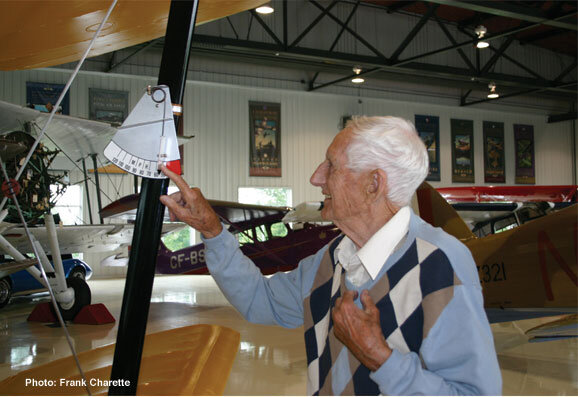A PENNY FOR YOUR THOUGHTS ARCHIE
Not long ago, I was asked by a friend to take his former father-in-law, a World War Two RAF veteran, on a personal tour of the Vintage Wings of Canada facility and collection. I jumped at the chance to meet this remarkable man and to learn his wonderful story.
Archie Pennie is a man of uncommon forthrightness, who continues to share with anyone interested, the nature and the detail of his personal experiences as an instructor pilot for the BCATP and as a de Havilland Mosquito pilot in Britain at the end of the war. Archie has long been a member of the Canadian Aviation Historical Society and over many years has contributed stories to the Ottawa Chapter's excellent Observair newsletter. Recently Pennie’s many written remembrances were compiled in a published memoir. An Airman Remembers is a lovely and kind-hearted insight into his aviation experiences and is now available to researchers in our library.
Before he signed up with the Royal Air Force, Archie was already a university graduate teaching chemistry in Scotland. The simple fact of his knowledge of chemical explosive compounds kept him out of the early years of the war, as he was considered vital to research and weapons development. But Archie longed to fly.
Eventually, Archie Pennie was granted a dispensation to join the RAF and soon found himself bound for Canada aboard RMS Letitia, a sister ship of the ill-fated Athenia torpedoed on the second day of the war, for an eleven day voyage across the Atlantic. He arrived in Halifax, was dispatched to an RAF manning depot in Moncton and shortly thereafter boarded a train for the long journey across a vast unknown land to Calgary where he began instruction at No. 32 EFTS Bowden, Alberta. At that time the RAF had ordered a large number of Boeing PT-27 Stearman trainers for primary flying training. They were delivered without many of the options requested by the RAF for instruction in the cold Canadian climate – the most important shortcoming being the lack of an enclosed cockpit. Despite these problems, they were employed until much better equipped Fairchild Cornell trainers could be supplied. Pennie and his fellow students considered themselves amongst an elite group of BCATP airmen who trained on the Stearman – a larger, more powerful biplane than the Tiger Moths and Fleet Finches also in use at the time.
After ab initio flight instruction, Pennie did his Service Flying Training in Harvards at No. 37 SFTS, Calgary. At the end of this training period, standing in line to read the list of operational postings, he was momentarily disappointed to read that he was chosen to be a flying instructor. Nearly everyone wanted to get into the fight; nearly everyone wanted fighters and an overseas posting. After Instructor training at No. 3 FIS Arnprior, Archie was assigned to No 34 EFTS Assiniboia. Assiniboia, a small town in South Saskatchewan, would play an important part in the training of Royal Air Force pilots during the war. Despite the initial feelings of disappointment, Pennie soon came to realize the importance of this role and he relished the unlimited flying opportunities and the honing of his piloting skills. Later in his operational career on Mosquitos, he would attribute his composure in the cockpit and indeed his survival to those thousands of flying hours at Assiniboia.
Once an instructor, always an instructor. Former BCATP flying instructor Archie Pennie demonstrates simplicity of the Tiger Moth’s air speed indicator to his grandson during tour of Vintage Wings of Canada hangar.
Pennie remembers well a young boy who lived with his family on a farm close to the Assiniboia runways. That young boy was named Harry Whereatt. Whereatt would be forever transformed by the building and operation of the British Commonwealth Air Training Plan base in his backyard. Though he would remain on the family farm, he became a pilot, an Aviation Maintenance Engineer and a collector of surplus military airframes and engines. Among many interesting types in his collection, Whereatt would rebuild and restore to flying condition a Hawker Hurricane XII and a Westland Lysander. In a remarkable and satisfying closing of a 60-year old circle, the ownership and stewardship of these rare aircraft would fall to Vintage Wings of Canada. “Oh my, where did you get the Lizzie?” cried Pennie when he set his eyes on the bright yellow and black striped Lysander. When he learned it had been rebuilt by the kid at the end of the Assiniboia runway, a wide smile appeared beneath his sparkling eyes.
Mission accomplished.
Archie is as proud of his family as he is of those years with the RAF. Here he stands with his grandson Alex Charette (right) and his former son-in-law Frank Charette and Frank’s youngest son Mark.








